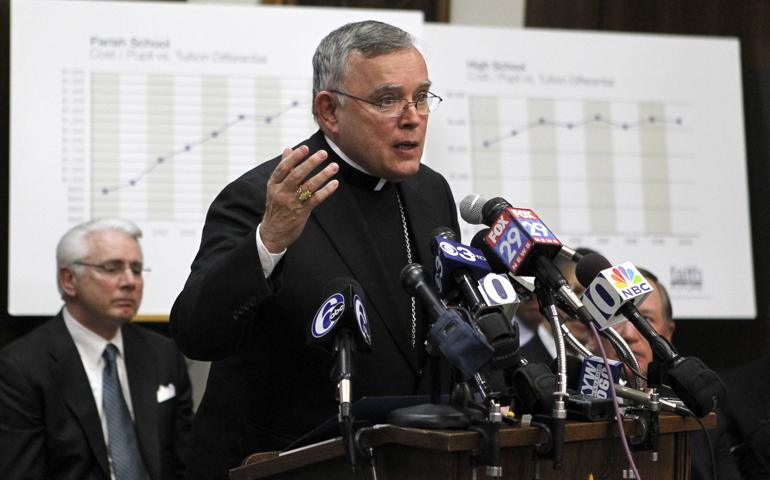
Archbishop Charles Chaput makes remarks during a news conference to announce the closing of 48 Catholic schools at the archdiocesan headquarters in Philadelphia Jan. 6, 2012. (CNS/Reuters/Tim Shaffer)
After a course correction impelled by decades of often secretive financial management decisions and an embezzlement crisis, the Philadelphia archdiocese is making progress toward tackling a chronic operating deficit and meeting its financial obligations.
In one sign of contrast with prior administrations, the archdiocese has begun to provide public, audited financial statements that reveal the magnitude of the task facing its chief financial officer.
"I think we're in the process of turning the corner, but it's a big corner," said CFO Tim O'Shaughnessy, who came on board in April 2012. Archbishop Charles Chaput, who arrived in 2011, has charged O'Shaughnessy with getting the archdiocese's financial house in order after former CFO Anita Guzzardi was charged with embezzling more than $900,000. In August 2012, she was sentenced to serve two to seven years in state prison for the theft.
In the fiscal year 2013, the Office of Financial Services, which provides administrative and program support for parishes, schools and other archdiocesan-related groups, incurred a $4.9 million recurring loss. That's a substantial reduction from the previous year, when the "core deficit" (a number that doesn't take into account one-time income and expenses) was $17.6 million.
Unique expenses for fiscal year 2012 included $11.9 million dedicated to legal and other professional fees related to investigations of the embezzlement and of clergy sex abuse, among other expenses, according to archdiocesan spokesman Ken Gavin.
Reported income for fiscal year 2013 showed a shift from a loss of $39.2 million to a $3.9 million surplus (which also included non-recurring income). The archdiocese undertook the move toward solvency with much financial belt-tightening and a decision to restructure many operations.
O'Shaughnessy said he expects that the loss for fiscal 2014 will be somewhere between $3 million and $5 million.
Financial statements released by the archdiocese March 14 for fiscal 2013 reveal increased financial stability for several significant archdiocesan ministries.
Matthew Gambino on CatholicPhilly.com reported, "The high schools showed a more dramatic swing in net assets: a $5.8 million gain in 2013, up from a $4 million loss in 2012. Investment gains appeared to be a major reason."
A narrative provided by the archdiocese for Catholic Health Care Services (CHCS) indicates that fiscal 2013 was also profitable. According to the archdiocese, there was "an operating excess of revenue over expenses before interest, depreciation and amortization expense of $3.9 million. The outstanding performance of CHCS in fiscal 2013 is also indicated with an increase in cash of $2.5 million, approximately." The agency is the seventh-largest faith-based provider of nursing homes and assisted living facilities in the U.S.
The picture was less positive for Catholic Social Services. That agency had "negative changes in net assets," according to archdiocesan documents, of $1.1 million, although it received millions of dollars in revenue from appeals, donations and investment returns. Catholic Social Services provides a broad range of services to children, adults and the elderly residents of southeastern Pennsylvania.
Within the past two years, the archdiocese has taken multiple steps to trim its losses. Some of these involve shedding brick-and-mortar edifices, and others, perhaps more painful, human capital.
When O'Shaughnessy took over as financial steward of the archdiocese, he faced four significant, chronic and pressing liabilities:
- $82 million borrowed from the Trust and Loan Fund, an entity created to invest parish deposits and use the assets to make loans to other parishes;
- A $30.4 million shortfall in the risk management program;
- A gap of more than $150 million in the lay employee retirement plan;
- A shortfall of around $92 million in the pension plan for clergy.
In 2012, the archdiocese sold the vacation home for retired priests in Ventnor, N.J., along with the archbishop's residence on City Line Avenue in Philadelphia. The management team also made staff cuts at the Archdiocesan Pastoral Center, resulting in layoffs for almost a quarter of its employees.
"The vast majority of individuals who work for the archdiocese are quite committed to the mission of the church and doing ... good and valuable work" said Gavin, adding that it was a "very sad time." The print version of the 150-year-old archdiocesan newspaper, The Catholic Standard & Times, disappeared, along with the youth ministry office.
Last September, the archdiocese signed an agreement with StoneMor Partners, a public company, to lease and manage its 13 archdiocesan cemeteries. The move allows the archdiocese to keep the properties but turn over the responsibility of burials and other day-to-day operations.
Currently, the archdiocese is seeking a buyer for its six nursing homes and an assisted care facility managed by Catholic Health Care Services. Archdiocesan officials say that they hope to ensure a continuing Catholic presence providing pastoral care in nursing homes if a transaction is completed.
Msgr. Joseph McLoone, pastor of the church next to nursing home St. Martha Manor and its sister senior living community, Villa St. Martha, is aware that for some, change can be difficult. "People don't want things to change, but sometimes they do change, and that's not necessarily a bad thing," he said.
Pastor of St. Joseph Church in Downingtown, Pa., McLoone said he thinks the facilities will continue to keep their "good neighbor policy" and maintain their high standards. In fact, he's considering one of the facilities for his own mother.
In addition to the layoffs at the pastoral center, the archdiocese also froze the defined benefit pension fund that supports all archdiocesan full-time, vested lay employees. Those employed by the archdiocese after July 1 will be enrolled in a defined contribution plan still under development.
Rita Schwartz, who represents area high school teachers for the Association of Catholic Teachers union, is eager to learn more proposal details, particularly the percentage the archdiocese will contribute to the pension plans. The union is currently in contract negotiations with the archdiocese.
"I believe that they have been forthcoming with us and have not attempted to hide," Schwartz said, adding that the uncertain state of archdiocesan finances isn't reassuring. "I would like to know more than I know now."
Whatever the flaws of the previous leadership for "not doing due diligence ... I'm giving the current archbishop his due," Schwartz said. "At least he's tried to get a handle on things, and get on a more even keel."
Gavin noted, "The problems didn't appear overnight. These are things that were built over the course of a couple of decades." He added that while "there is no immediate fix, and they are going to take time, we are getting there."
Thanks to a more efficient collection of parish assessments, donations and budding support from a new nonprofit, the Catholic Foundation of Greater Philadelphia, O'Shaughnessy said he is hopeful about some cash flow improvement on the revenue side of the ledger.
But there are still unknowns, including the outcome of 22 civil cases alleging sexual abuse by priests.
At the same time, Jesuit Fr. Tom Gaunt, director of Georgetown University's Center for Applied Research in the Apostolate, said local churches (which provide revenue for the archdiocese) face the challenges of changing populations. Like many other dioceses in the Northeast and Midwest, Philadelphia has a surplus of aging worship spaces with a shrinking group of worshipers to support them financially.
Given the financial problems affecting local parishes, Chaput and other church leaders have limited options when it comes to finding revenue, according to Gaunt.
"It's not lost on us that the process has been hard and painful," O'Shaughnessy added, citing the impact of properties sold and ministries eliminated. But because of the severity of the financial problems facing the archdiocese, "we've had to do something a little more extraordinary."
[Elizabeth Eisenstadt-Evans is a religion columnist at Lancaster Newspapers Inc. and a freelance writer living in Glenmoore, Pa.]




